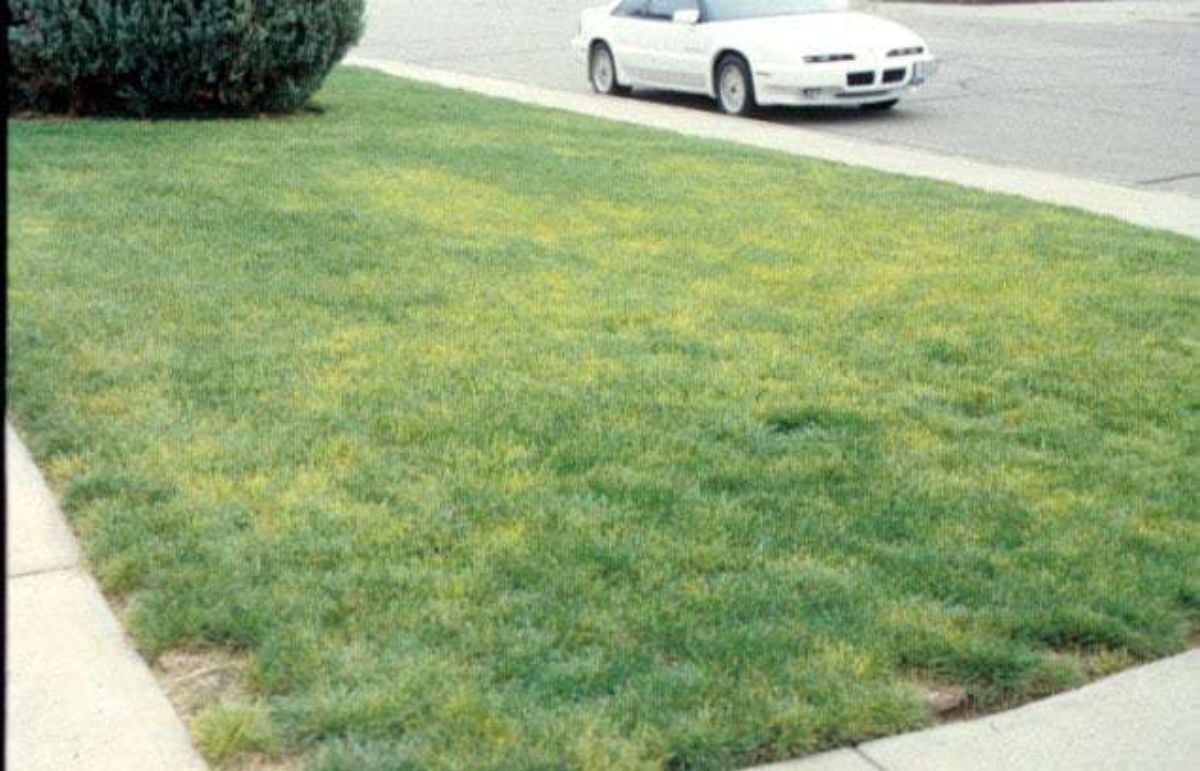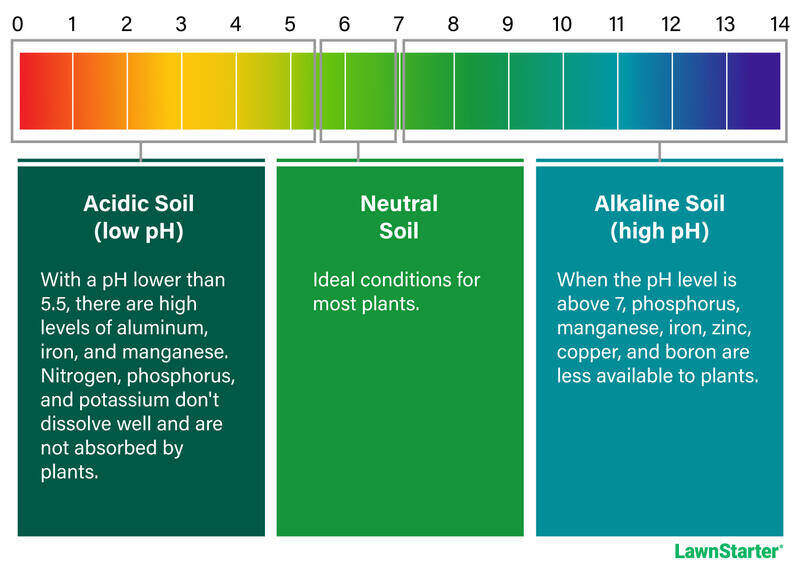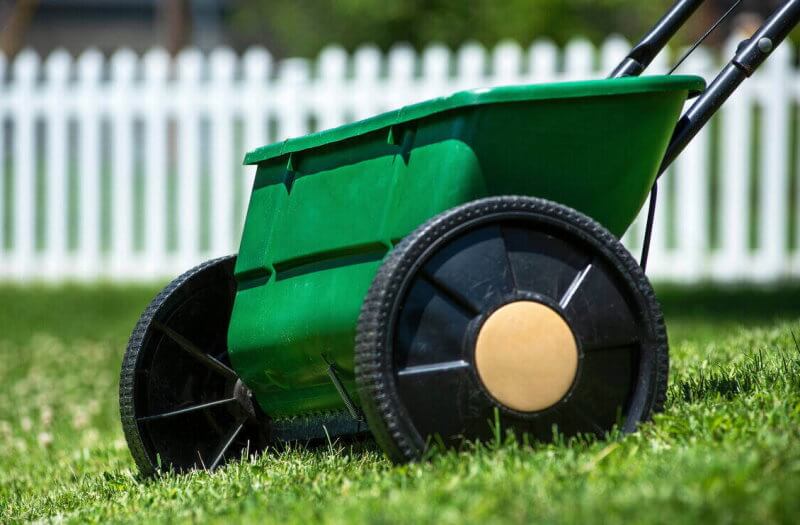
Uh oh! You were excited to show off your green lawn, but why is it turning yellow? Nitrogen fertilizer may seem like a quick fix, but it won’t help if you’re dealing with iron chlorosis. Let’s define this condition and go over how to treat iron chlorosis in your lawn.
What Is Iron Chlorosis?
Iron chlorosis is an iron deficiency in grass, trees, and shrubs. When turfgrass can’t absorb iron from the soil, green chlorophyll fails to develop. Chlorophyll makes plants green and, more importantly, allows them to absorb sunlight for energy. Symptoms of iron chlorosis usually show up when new growth begins.
What Causes Iron Chlorosis?
There are two main causes of iron chlorosis in the lawn:
- There isn’t enough iron in your soil.
- Your grass can’t access the available iron in your soil.

You may ask: if the iron is there, what’s stopping the grass from absorbing it? High pH is likely the answer. Soil pH measures acidity and alkalinity in your soil on a scale of 0 (most acidic) to 14 (most alkaline). The ideal pH for most grasses is between 6.0 and 7.0.
Alkaline soils with a high pH interfere with the uptake of iron. Get a soil test from your local cooperative extension or soil testing laboratory to see where your yard’s pH lies.
Note: Excessive phosphorus, soil temperature, rainfall, soil moisture or dryness, and light intensity also affect iron uptake.
How to Get Rid of Iron Chlorosis
Perform a soil test to see whether your soil is lacking iron or has a high pH. Once armed with that knowledge, you’re ready to start treatment.
Low Iron Levels
If your soil test showed an iron deficiency, apply an iron supplement. You can choose from a variety of products, including the following.
- Ferrous sulfate (AKA iron sulfate) is applied as a spray solution and works for about three weeks. It also lowers soil pH, acting as a two-in-one solution. If a soil test reveals your soil has a low pH, ferrous sulfate might not be the best solution.
- Iron chelates last longer than ferrous sulfate. The label should say what pH range is ideal for the iron.
- Trace element fertilizer contains iron, but it also includes other elements like zinc and manganese. It could be a good solution if your soil test shows multiple trace element deficiencies.
Read all product labels carefully. Not all products will need to be watered in.
Pro tip: According to Oregon State University, fertilizers containing iron can stain sidewalks and driveways when wet. Blow or sweep any excess iron back into the lawn before you water it.
High Soil pH
If your soil pH is the underlying problem, iron applications won’t offer a long-term solution. Why? Because your turf can’t access available iron when the pH is too high. Keep the pH between 6.0 and 7.0 for ideal iron absorption.
Check your soil test results to see what amendments your lawn needs. If your soil needs lower pH and iron supplementation, use ferrous sulfate. If it has enough iron but the pH is too high, use sulfur soil amendments. Refer to your soil test for the recommended amount to apply.
Soil amendments can take a while to break down. Check on your soil’s progress every six months with a soil test.
How to Identify Iron Chlorosis
Iron chlorosis looks different depending on how far it’s progressed. It starts as a slight yellowish-green color in the uppermost grass leaves, where new growth occurs. That’s because the new leaves can’t properly develop chlorophyll.
At this point, the oldest grass may still be dark green. However, the yellow may spread down the whole plant and can even turn the leaves whitish-yellow. Iron chlorotic grass can jump straight to this stage without the green and yellow stage first. In that case, you must act quickly.
If left untreated, grass could begin to die in irregular patterns. The younger leaves will succumb to iron chlorosis before the older ones.
Iron Chlorosis vs. Nitrogen Deficiency
A yellow lawn isn’t always caused by iron chlorosis. Nitrogen deficiency has similar symptoms, but here’s how to tell them apart.
| Iron Chlorosis | Nitrogen Deficiency |
| Upper/younger grass leaves turn yellow before the old growth | Lower/older grass leaves turn yellow before the new growth |
| Before turning yellow, the grass will be light green on the top and dark green on the bottom | The leaves will show several shades of light green on a single leaf |
Why does it matter what the deficiency is? Can’t you just apply iron and nitrogen to cover all your bases? It is crucial that you identify the problem before treatment. Nitrogen applications on iron-deficient turf can cause leaves to turn white or die.
Still not sure which one you’re dealing with? A soil test will show how much of each nutrient is present. Carefully read the instructions or forms that come with the soil test to ensure it tests for iron and nitrogen.
Note: A laboratory soil test is the best way to distinguish between these problems. If you can’t access professional soil testing, try the following:
Step 1: Choose a small spot on your lawn to test (15 by 15 feet or smaller).
Step 2: If you suspect a nitrogen deficiency, apply fertilizer to that spot only. Make sure the fertilizer has nitrogen but no iron in it. The percentage of nitrogen is represented by the first of the three large numbers on the fertilizer package, called an NPK ratio. The iron content should be in the small text somewhere else on the bag. Water the fertilizer in and wait a week or so. If your grass greens up again, it has a nitrogen deficiency.
If you suspect an iron deficiency, apply an iron product to a small spot on your lawn. Make sure there is no nitrogen in the product you choose. Apply based on the product instructions and let sit for 24 hours before mowing the lawn. Wait a few days and see if the turf starts to green up again. If it does, then iron deficiency was the problem.
Step 3: If neither of the above solutions green up your yellow grass, check your soil pH with an at-home soil test kit. A pH that’s too high or too low might be affecting nutrient absorption. Remember, the ideal pH is between 6.0 and 7.0 for most grasses.
How to Prevent Iron Chlorosis
Want to save yourself a headache? Here are the lawn maintenance practices you can implement to prevent iron chlorosis in the first place.
- Get soil tests regularly (about once a year) to check pH and iron levels. That way, you can prevent iron chlorosis before you see the first yellow leaf.
- Aerate your soil. Soil compaction makes it difficult for your grass to absorb nutrients, including iron. Aeration creates small holes in the ground, allowing nutrients, air, and water to reach the grass roots while relieving compact soil. It also makes soil amendments more effective.
- Don’t overwater. Excessive irrigation can make iron chlorosis worse. Irrigate your lawn less frequently for longer periods to help it develop a deep root system. These deep roots will absorb nutrients more effectively than short roots.
How to Repair Damage from Iron Chlorosis

Quick, decisive action can stop or reverse the effects of iron chlorosis. But what if your lawn is already damaged? A severe case of iron chlorosis could kill your grass. In that case, you may need to install new sod or overseed to thicken your lawn again (after you’ve treated the underlying problem, of course).
What Grasses Are Most Susceptible to Iron Chlorosis?
Many grass types can suffer from iron chlorosis, including:
- Bermudagrass
- Centipedegrass
- Creeping bentgrass
- Kentucky bluegrass
- Ryegrass
- St. Augustinegrass
- Tall fescue
Note: Some cultivars of the same grass type are less prone to iron chlorosis than others. For example, Floratam St. Augustine grass is less likely to show symptoms of iron chlorosis than other St. Augustine varieties.
When to Hire a Professional
Soil tests, amendments, iron applications–– when correcting lawn problems becomes overwhelming, turn to the pros. Connect with a local lawn care professional who can maintain your lawn’s beauty and health with mowing, aeration, and fertilization.
Main Image Credit: Courtesy of Kansas State University Research and Extension